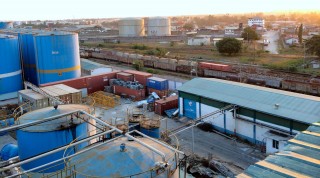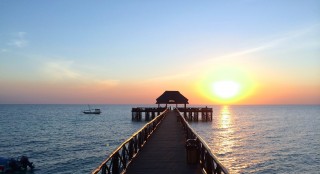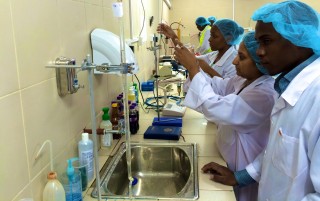The sun is shining on Aiwiaso, a village of 6,600 people in western Ghana. Some 200 kilometres north of the Ghanaian port at Takoradi, 100 kilometres east of the border with the Ivory Coast, the biggest solar power plant ever conceived on the continent is taking shape. Promising enough energy to power 100,000 homes, this may well change the way African governments think about the future of energy.
Scheduled for completion in October 2016, the Nzema solar power plant will be not just the largest in Africa but one of the largest in the world. It will add to Ghana’s current electricity generation capacity by 5.5 percent. And it will get the country 20 percent of the way to the 2020 goal set by the country’s 2011 Renewable Energy Act – to source 10 percent of its total energy from renewable sources. The project will cover 182 hectares, its 630,000 photovoltaic panels mounted on 37,000 tonnes of supporting steel framework with 2,000 kilometres of connecting cables.
The solar array will be huge but the vision behind this plant is even bigger: it will be the first test of the country’s ability to meet its energy act goals. If it is seen as a success, Ghana should be able to attract more investors like the UK-based Blue Energy Group, which was chosen in December 2012 to build Nzema.
Ghana wants to increase its electricitygeneration from 2,846 MW today to 5,000 MW by 2016, and the Nzema plant will contribute 155 MW, but there are other benefits. Nzema is expected to create 200 permanent jobs for Ghanaians. More reliable power thanks to the plant could create 2,100 more jobs throughout the economy. Finally, the plant is expected to pay $100 million in taxes to Ghana during its estimated 20-year operating lifetime.
Soaking up Some Rays
The 630,000-plus panels planned for Aiwiaso are photovoltaic (PV). When sunlight strikes a photovoltaic panel, it generates direct current (DC) electricity, which is then converted into alternating current (AC) for transmission by an inverter. Photovoltaics are cheaper and more flexible than concentrated solar power, an alternate technique that requires an array of mirrors and a turbine, and they do not require a source of water. They can even generate electricity on cloudy days. One disadvantage of the photovoltaic method is that the power captured cannot yet be stored economically. Since Ghana is short of power, however, the electricity generated will be injected directly into the grid, making this less of an issue.
A Hopeful Forecast
Since 1965, when the Akosombo dam was built to provide power for an aluminium smelter in Tema, Ghana has depended on hydroelectric power, a source that worked well until 1983. Since then, the country has seen increasingly frequent droughts, which not only disrupt power but have caused food shortages and much suffering. A major drought in 2006-2007, and one beginning in 2012 that arguably continues today, have required load shedding (rolling blackouts). In December 2013, the acting CEO of the Volta River Authority (VRA), Kirk Coffie, assured Ghanaians that there would be no load shedding in 2014, but already by January the VRA’s Communications Director was warning consumers of a possible power crisis due to low water levels at Akosombo.
For over 10 years, Ghana has been working to reduce its vulnerability to droughts. It has significantly cut its proportion of hydroelectric power from 91.5 percent of total power in 2000 to 67.5 percent in 2011. The belief that has propelled the Renewable Energy Act is that solar power will become a more reliable source of energy. It has a particular advantage in Africa in that much of the continent’s terrain is ideal for solar installations.
The technology will not develop in the region without private investment. Until Ghana passed the Renewable Energy Act with an eye to winning private funding for such projects, an unsupportive regulatory environment and energy under pricing had discouraged investors.
Even before the Renewable Energy Act was passed, Ghana had decided to follow the path of deregulation of the electricity sector. According to Doug Coleman, the Project Director for Nzema at Blue Energy, the firm that is building the plant, the state began privatising its power assets when it separated electricity generation from transmission and distribution.
Privatisation is far from complete but its impact on the sector is already showing. The government has by now stopped building new plants using state funds – although it does still hold the shares of the Ghana Grid Company (GRIDCo), Electricity Company of Ghana and the Volta River Authority (VRA), the country’s main energy suppliers. The Renewable Energy Act guarantees investors a fixed tariff for the first 10 years and biannual reviews after that for the life of the plant. The country is also building a legal framework for regulating renewable energy projects that integrates its two energy regulatory bodies, an Energy Commission that gives approval to projects and a Public Utilities Regulatory Commission that, among other things, sets incentivising tariffs. These changes are making Ghana a more appealing environment for outside renewable energy investors.
The Nzema plant itself is a positive sign. Blue Energy became involved in Ghana after hearing about its plan to attract private investors with feed-in tariffs, a favourable kWh price set to encourage investment in renewable energy. The firm has completed six projects since its 2010 founding – three solar and three wind – and currently has nine renewable energy projects including Nzema at various stages of progress. The Ghanaian plant is the company’s first big project outside the UK.
Blue Energy received the country’s first private renewable energy license. Its feed-in tariff has been publicly set at $0.20 per kWh. With a projected capacity of 240,000 Mwh per year and an estimated plant cost of $400 million, Nzema could break even in less than 11 years. Obtaining Ghana’s first renewable energy licence has brought challenges, naturally. “Converting high-level strategic policy into procedures and processes takes time, especially when the existing procedures weren’t written with renewables in mind,” says Coleman. Blue Energy’s environmental permit process was especially rigorous, taking two and a half years. Coleman, who is confident that all the paperwork will be in order by the time Blue Energy is ready to begin construction in summer 2014, believes this is a good thing. Although the Ghanaian government is still shaping registration procedures and regulations, Coleman calls the authorities “very clear,” “very transparent,” and “delightful” to work with, and says they provide “strong guidance.” “You know what you have to do,” he says.
Blue Energy appears to be in Ghana for the long term. The business climate for renewables in the UK is not altogether favourable – feed-in tariffs there are dropping, especially for larger installations, and in October 2013, Prime Minister Cameron pledged to roll back “green charges” in order to reduce electric bills. On the Ghanaian side, the company has committed to funding education and healthcare facilities in the Aiwiaso area and to supporting small businesses. Communities in the area of the plant will also receive land lease revenues.
According to Coleman, financing should be locked in by the end of the second quarter of 2014, and construction will start by the end of the year. Blue Energy is still talking to three engineering, procurement and construction contractors but is close to making a decision. Its 630,000 photovoltaic panels are expected to come from a market-leading manufacturer in China.
A Dawning Opportunity
Ghana’s government is actively courting investors from all over the world to help realise the dream of a renewable- powered Ghana – one where Ghanaians benefit and the country becomes an exporter of electricity and fuel. At the beginning of 2014, Emmanuel Armah- Kofi Buah, the country’s Minister of Energy and Petroleum, promised “universal access to electricity” by 2016. And in an interview in February 2013, Ghana’s former energy minister, Joe Oteng-Adjei, offered international backers transparency and integrity and vowed that the country would not nationalise any investments.
Blue Energy is not the only major foreign energy company beginning work in Ghana. The Abu Dhabi National Energy Company, TAQA, is investing $330 million to increase the capacity of the Takoradi II thermal power plant by 50 percent. The project will convert the gas-fired plant into a combined-cycle unit without increasing its carbon emissions. Jacobsen Jelco Ghana Ltd, a subsidiary of Jacobsen Elektro Holding of Norway, plans to build a 360-MW thermal power plant at Aboadze. Furthermore, the State Atomic Energy Corporation of Russia is negotiating with Ghana to build a nuclear power plant that would be completed sometime after 2016.
The country realises that simply increasing its capacity for electricity generation will not assure reliable power. It is also taking steps to eliminate congestion in its transmission system by the end of 2015; to increase delivery efficiency and reduce system losses; and to further promote conservation and energy-efficient technologies. In 2013, construction began on two new 161 kV transmission lines and three new 330 kV lines.
A Place in the Sun
Since 90 percent of Blue Energy’s building materials will be imported, the plant site had to be connected by good roads to a deep-water port. Aiwiaso’s proximity to the port of Takoradi, its abundant, stable solar irradiation and its adjacency to the 161 kV West African Power Pool transmission line made it a solid choice. The company has secured port access at Takoradi. The West African Highway, which runs from there to Aiwiaso, is being enlarged from two to three lanes.
The sun will always shine but clouds are less reliable by nature. Coleman points out that fluctuations in sunlight – and in the resulting ability to generate power – have meant a learning curve as the company works with GRIDCo and network operators to integrate this variable supply into Ghana’s existing system. Countries like Kenya and Uganda already have some experience with integrating variable loads and working with Ghana to implement these new systems has been an “enjoyable challenge,” Coleman says. The sentiment seems sincere. If the weather is never 100 percent reliable even in this part of the world, there’s one thing that is for certain, Coleman concludes, “the plant will get built”
By Joshua Shoemake








